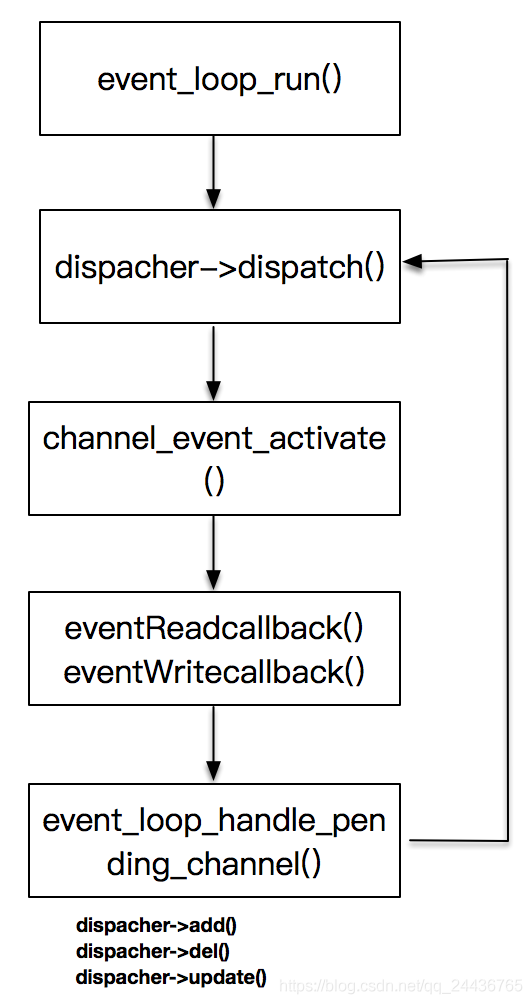在开始编写高性能HTTP服务器之前,先来构建一个支持TCP的高性能网络编程框架,再增加HTTP特性的支持就比较容易了。
github:https://github.com/froghui/yolanda
需求提出
首先,TCP 高性能网络框架需要满足的需求有以下三点:
第一,采用 reactor 模型,可以灵活使用 poll/epoll 作为事件分发实现。
第二,必须支持多线程,从而可以支持单线程单 reactor 模式,也可以支持多线程主 - 从 reactor 模式。可以将套接字上的 I/O 事件分离到多个线程上。
第三,封装读写操作到 Buffer 对象中。
按照这三个需求,正好可以把整体设计思路分成三块来讲解,分别包括反应堆模式设计、I/O 模型和多线程模型设计、数据读写封装和 buffer。
反应堆模式设计思路
主要是设计一个基于事件分发和回调的反应堆框架。这个框架里面的主要对象包括:
- event_loop
你可以把 event_loop 这个对象理解成和一个线程绑定的无限事件循环,你会在各种语言里看到 event_loop 这个抽象。这是什么意思呢?简单来说,它就是一个无限循环着的事件分发器,一旦有事件发生,它就会回调预先定义好的回调函数,完成事件的处理。
具体来说,event_loop 使用 poll 或者 epoll 方法将一个线程阻塞,等待各种 I/O 事件的发生。
- channel
对各种注册到 event_loop 上的对象,我们抽象成 channel 来表示,例如注册到 event_loop 上的监听事件、套接字读写事件等。在各种语言的 API 里,你都会看到 channel 这个对象,大体上它们表达的意思跟我们这里的设计思路是比较一致的。
- acceptor
acceptor 对象表示的是服务器端监听器,acceptor 对象最终会作为一个 channel 对象,注册到 event_loop 上,以便进行连接完成的事件分发和检测。
- event_dispatcher
event_dispatcher 是对事件分发机制的一种抽象,也就是说,可以实现一个基于 poll 的 poll_dispatcher,也可以实现一个基于 epoll 的 epoll_dispatcher。在这里,我们统一设计一个 event_dispatcher 结构体,来抽象这些行为。
- channel_map
channel_map 保存了描述字到 channel 的映射,这样就可以在事件发生时,根据事件类型对应的套接字快速找到 chanel 对象里的事件处理函数。
I/O 模型和多线程模型设计思路
主要解决 event_loop 的线程运行问题,以及事件分发和回调的线程执行问题。
- thread_pool
struct thread_pool {
//创建thread_pool的主线程
struct event_loop *mainLoop;
//是否已经启动
int started;
//线程数目
int thread_number;
//数组指针,指向创建的event_loop_thread数组
struct event_loop_thread *eventLoopThreads;
//表示在数组里的位置,用来决定选择哪个event_loop_thread服务
int position;
};
struct thread_pool *thread_pool_new(struct event_loop *mainLoop, int threadNumber);
void thread_pool_start(struct thread_pool *);
struct event_loop *thread_pool_get_loop(struct thread_pool *);thread_pool 维护了一个 sub-reactor 的线程列表,它可以提供给主 reactor 线程使用,每次当有新的连接建立时,可以从 thread_pool 里获取一个线程,以便用它来完成对新连接套接字的 read/write 事件注册,将 I/O 线程和主 reactor 线程分离。
- event_loop_thread
struct event_loop_thread {
struct event_loop *eventLoop;
pthread_t thread_tid; /* thread ID */
pthread_mutex_t mutex;
pthread_cond_t cond;
char * thread_name;
long thread_count; /* # connections handled */
};
//初始化已经分配内存的event_loop_thread
int event_loop_thread_init(struct event_loop_thread *, int);
//由主线程调用,初始化一个子线程,并且让子线程开始运行event_loop
struct event_loop *event_loop_thread_start(struct event_loop_thread *);event_loop_thread 是 reactor 的线程实现,连接套接字的 read/write 事件检测都是在这个线程里完成的。
Buffer 和数据读写的设计思路
- buffer
#define INIT_BUFFER_SIZE 65536
//数据缓冲区
struct buffer {
char *data; //实际缓冲
int readIndex; //缓冲读取位置
int writeIndex; //缓冲写入位置
int total_size; //总大小
};
struct buffer *buffer_new();
void buffer_free(struct buffer *buffer);
int buffer_writeable_size(struct buffer *buffer);
int buffer_readable_size(struct buffer *buffer);
int buffer_front_spare_size(struct buffer *buffer);
//往buffer里写数据
int buffer_append(struct buffer *buffer, void *data, int size);
//往buffer里写数据
int buffer_append_char(struct buffer *buffer, char data);
//往buffer里写数据
int buffer_append_string(struct buffer*buffer, char * data);
//读socket数据,往buffer里写
int buffer_socket_read(struct buffer *buffer, int fd);
//读buffer数据
char buffer_read_char(struct buffer *buffer);
//查询buffer数据
char * buffer_find_CRLF(struct buffer * buffer);buffer 对象屏蔽了对套接字进行的写和读的操作,如果没有 buffer 对象,连接套接字的 read/write 事件都需要和字节流直接打交道,这显然是不友好的。所以,我们也提供了一个基本的 buffer 对象,用来表示从连接套接字收取的数据,以及应用程序即将需要发送出去的数据。
- tcp_connection
struct tcp_connection {
struct event_loop *eventLoop;
struct channel *channel;
char *name;
struct buffer *input_buffer; //接收缓冲区
struct buffer *output_buffer; //发送缓冲区
connection_completed_call_back connectionCompletedCallBack;
message_call_back messageCallBack;
write_completed_call_back writeCompletedCallBack;
connection_closed_call_back connectionClosedCallBack;
void * data; //for callback use: http_server
void * request; // for callback use
void * response; // for callback use
};
struct tcp_connection *
tcp_connection_new(int fd, struct event_loop *eventLoop, connection_completed_call_back
connectionCompletedCallBack, connection_closed_call_back connectionClosedCallBack,
message_call_back messageCallBack, write_completed_call_back writeCompletedCallBack);
//应用层调用入口
int tcp_connection_send_data(struct tcp_connection *tcpConnection, void *data, int size);
//应用层调用入口
int tcp_connection_send_buffer(struct tcp_connection *tcpConnection, struct buffer * buffer);
void tcp_connection_shutdown(struct tcp_connection * tcpConnection);tcp_connection 这个对象描述的是已建立的 TCP 连接。它的属性包括接收缓冲区、发送缓冲区、channel 对象等。这些都是一个 TCP 连接的天然属性。tcp_connection 是大部分应用程序和我们的高性能框架直接打交道的数据结构。我们不想把最下层的 channel 对象暴露给应用程序,因为抽象的 channel 对象不仅仅可以表示 tcp_connection,前面提到的监听套接字也是一个 channel 对象,后面提到的唤醒 socketpair 也是一个 channel 对象。所以,我们设计了 tcp_connection 这个对象,希望可以提供给用户比较清晰的编程入口。
反应堆模式具体设计
event_loop运行详图:

当 event_loop_run 完成之后,线程进入循环,首先执行 dispatch 事件分发,一旦有事件发生,就会调用 channel_event_activate 函数,在这个函数中完成事件回调函数 eventReadcallback 和 eventWritecallback 的调用,最后再运行event_loop_handle_pending_channel,用来修改当前监听的事件列表,完成这个部分之后,又进入了事件分发循环。
- event_loop 分析
说 event_loop 是整个反应堆模式设计的核心,一点也不为过。先看一下 event_loop 的数据结构。在这个数据结构中,最重要的莫过于 event_dispatcher 对象了。你可以简单地把 event_dispatcher 理解为 poll 或者 epoll,它可以让我们的线程挂起,等待事件的发生。这里有一个小技巧,就是 event_dispatcher_data,它被定义为一个 void * 类型,可以按照我们的需求,任意放置一个我们需要的对象指针。这样,针对不同的实现,例如 poll 或者 epoll,都可以根据需求,放置不同的数据对象。event_loop 中还保留了几个跟多线程有关的对象,如 owner_thread_id 是保留了每个 event loop 的线程 ID,mutex 和 con 是用来进行线程同步的。socketPair 是父线程用来通知子线程有新的事件需要处理。pending_head 和 pending_tail 是保留在子线程内的需要处理的新的事件。
struct event_loop {
int quit;
const struct event_dispatcher *eventDispatcher;
/** 对应的event_dispatcher的数据. */
void *event_dispatcher_data;
struct channel_map *channelMap;
int is_handle_pending;
struct channel_element *pending_head;
struct channel_element *pending_tail;
pthread_t owner_thread_id;
pthread_mutex_t mutex;
pthread_cond_t cond;
int socketPair[2];
char *thread_name;
};下面我们看一下 event_loop 最主要的方法 event_loop_run 方法,前面提到过,event_loop 就是一个无限 while 循环,不断地在分发事件。
/**
* 1.参数验证
* 2.调用dispatcher来进行事件分发,分发完回调事件处理函数
*/
int event_loop_run(struct event_loop *eventLoop) {
assert(eventLoop != NULL);
struct event_dispatcher *dispatcher = eventLoop->eventDispatcher;
if (eventLoop->owner_thread_id != pthread_self()) {
exit(1);
}
yolanda_msgx("event loop run, %s", eventLoop->thread_name);
struct timeval timeval;
timeval.tv_sec = 1;
while (!eventLoop->quit) {
//block here to wait I/O event, and get active channels
dispatcher->dispatch(eventLoop, &timeval);
//handle the pending channel
event_loop_handle_pending_channel(eventLoop);
}
yolanda_msgx("event loop end, %s", eventLoop->thread_name);
return 0;
}代码很明显地反映了这一点,这里我们在 event_loop 不退出的情况下,一直在循环,循环体中调用了 dispatcher 对象的 dispatch 方法来等待事件的发生。
- event_dispacher 分析
为了实现不同的事件分发机制,这里把 poll、epoll 等抽象成了一个 event_dispatcher 结构。event_dispatcher 的具体实现有 poll_dispatcher 和 epoll_dispatcher 两种。
/** 抽象的event_dispatcher结构体,对应的实现如select,poll,epoll等I/O复用. */
struct event_dispatcher {
/** 对应实现 */
const char *name;
/** 初始化函数 */
void *(*init)(struct event_loop * eventLoop);
/** 通知dispatcher新增一个channel事件*/
int (*add)(struct event_loop * eventLoop, struct channel * channel);
/** 通知dispatcher删除一个channel事件*/
int (*del)(struct event_loop * eventLoop, struct channel * channel);
/** 通知dispatcher更新channel对应的事件*/
int (*update)(struct event_loop * eventLoop, struct channel * channel);
/** 实现事件分发,然后调用event_loop的event_activate方法执行callback*/
int (*dispatch)(struct event_loop * eventLoop, struct timeval *);
/** 清除数据 */
void (*clear)(struct event_loop * eventLoop);
};- channel 对象分析
channel 对象是用来和 event_dispather 进行交互的最主要的结构体,它抽象了事件分发。一个 channel 对应一个描述字,描述字上可以有 READ 可读事件,也可以有 WRITE 可写事件。channel 对象绑定了事件处理函数 event_read_callback 和 event_write_callback。
typedef int (*event_read_callback)(void *data);
typedef int (*event_write_callback)(void *data);
struct channel {
int fd;
int events; //表示event类型
event_read_callback eventReadCallback;
event_write_callback eventWriteCallback;
void *data; //callback data, 可能是event_loop,也可能是tcp_server或者tcp_connection
};- channel_map 对象分析
event_dispatcher 在获得活动事件列表之后,需要通过文件描述字找到对应的 channel,从而回调 channel 上的事件处理函数 event_read_callback 和 event_write_callback,为此,设计了 channel_map 对象。
/**
* channel映射表, key为对应的socket描述字
*/
struct channel_map {
void **entries;
/* The number of entries available in entries */
int nentries;
};channel_map 对象是一个数组,数组的下标即为描述字,数组的元素为 channel 对象的地址。比如描述字 3 对应的 channel,就可以这样直接得到。
struct chanenl * channel = map->entries[3];这样,当 event_dispatcher 需要回调 channel 上的读、写函数时,调用 channel_event_activate 就可以,下面是 channel_event_activate 的实现,在找到了对应的 channel 对象之后,根据事件类型,回调了读函数或者写函数。注意,这里使用了 EVENT_READ 和 EVENT_WRITE 来抽象了 poll 和 epoll 的所有读写事件类型。
int channel_event_activate(struct event_loop *eventLoop, int fd, int revents) {
struct channel_map *map = eventLoop->channelMap;
yolanda_msgx("activate channel fd == %d, revents=%d, %s", fd, revents, eventLoop->thread_name);
if (fd < 0)
return 0;
if (fd >= map->nentries)
return (-1);
struct channel *channel = map->entries[fd];
assert(fd == channel->fd);
if (revents & (EVENT_READ)) {
if (channel->eventReadCallback)
channel->eventReadCallback(channel->data);
}
if (revents & (EVENT_WRITE)) {
if (channel->eventWriteCallback)
channel->eventWriteCallback(channel->data);
}
return 0;
}- 增加、删除、修改 channel event
那么如何增加新的 channel event 事件呢?这几个函数是用来增加、删除和修改 channel event 事件的。
int event_loop_add_channel_event(struct event_loop *eventLoop, int fd, struct channel *channel1);
int event_loop_remove_channel_event(struct event_loop *eventLoop, int fd, struct channel *channel1);
int event_loop_update_channel_event(struct event_loop *eventLoop, int fd, struct channel *channel1);前面三个函数提供了入口能力,而真正的实现则落在这三个函数上:
int event_loop_handle_pending_add(struct event_loop *eventLoop, int fd, struct channel *channel);
int event_loop_handle_pending_remove(struct event_loop *eventLoop, int fd, struct channel *channel);
int event_loop_handle_pending_update(struct event_loop *eventLoop, int fd, struct channel *channel);我们看一下其中的一个实现,event_loop_handle_pendign_add 在当前 event_loop 的 channel_map 里增加一个新的 key-value 对,key 是文件描述字,value 是 channel 对象的地址。之后调用 event_dispatcher 对象的 add 方法增加 channel event 事件。注意这个方法总在当前的 I/O 线程中执行。
// in the i/o thread
int event_loop_handle_pending_add(struct event_loop *eventLoop, int fd, struct channel *channel) {
yolanda_msgx("add channel fd == %d, %s", fd, eventLoop->thread_name);
struct channel_map *map = eventLoop->channelMap;
if (fd < 0)
return 0;
if (fd >= map->nentries) {
if (map_make_space(map, fd, sizeof(struct channel *)) == -1)
return (-1);
}
//第一次创建,增加
if ((map)->entries[fd] == NULL) {
map->entries[fd] = channel;
//add channel
struct event_dispatcher *eventDispatcher = eventLoop->eventDispatcher;
eventDispatcher->add(eventLoop, channel);
return 1;
}
return 0;
}总结
在这一讲里,我们介绍了高性能网络编程框架的主要设计思路和基本数据结构,以及反应堆设计相关的具体做法。
温故而知新!